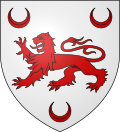Alaigne
Alaigne | |
|---|---|
 | |
| Country | France |
| Region | Occitania |
| Department | Aude |
| Arrondissement | Limoux |
| Canton | Alaigne |
| Intercommunality | Coteaux du Razès |
| Government | |
| • Mayor (2001–2020) | Jean Perrillou |
| Area 1 | 13.86 km2 (5.35 sq mi) |
| Population (2009) | 339 |
| • Density | 24/km2 (63/sq mi) |
| Time zone | UTC+01:00 (CET) |
| • Summer (DST) | UTC+02:00 (CEST) |
| INSEE/Postal code | 11004 /11240 |
| Elevation | 244–444 m (801–1,457 ft) (avg. 330 m or 1,080 ft) |
| 1 French Land Register data, which excludes lakes, ponds, glaciers > 1 km2 (0.386 sq mi or 247 acres) and river estuaries. | |
Alaigne (Alanha in Occitan) is a French commune in the Aude department in the Occitanie region of southern France.
The inhabitants of the commune are known as Alaignois or Alaignoises'[1]
Geography
The commune is located some 10 km north-west of Limoux and 20 km east of Mirepoix. A number of district roads all converge on the village of Alaigne: the D102 south from Belveze-du-Razes, the D702 west from Routier, the D102 north-west from Limoux, and the D52 which comes east from Bellegarde-du-Razes then continues south to Villelongue-d'Aude.[2]
The village itself is a traditional Circulade located in the historical region of Razès.
The commune is mostly farmland with a few scattered forests. There are no villages or hamlets other than Alaigne.
Neighbouring communes and towns[2]
Heraldry
 |
This is the arms of the last Archbishop of Narbonne, Arthur Richard Dillon.
The communes of Bize-Minervois, Gruissan, Pieusse, and Routier which were also strongholds of the Archbishop of Narbonne have the same arms. Blazon:
|
History
Before the Revolution, Alaigne was a part of Pieusse and Routier was a barony of the Archbishop of Narbonne.[4]
Administration
List of Successive Mayors of Alaigne[5]
| From | To | Name | Party | Position |
|---|---|---|---|---|
| 1906 | 1912 | Urbain Frontil | Consul General | |
| 2001 | 2020 | Jean Perrillou |
(Not all data is known)
Demography
In 2010, the commune had 340 inhabitants. The evolution of the number of inhabitants is known through the population censuses conducted in the town since 1793. From the 21st century, a census of municipalities with fewer than 10,000 inhabitants is held every five years, unlike larger towns that have a sample survey every year.[Note 1]
Template:Table Population Town

Culture and heritage
Civil heritage
- The Porte de Papi Fortified door (15th century)
 is registered as an historical monument.[6]
is registered as an historical monument.[6]
Religious heritage
- The Cemetery contains a number of items that are registered as historical objects:
- The Parish Church of Saint-Pierre es Liens contains a number of items that are registered as historical objects:
See also
External links
- Alaigne on the National Geographic Institute website
- Alaigne on Lion1906
- Alaigne on Google Maps
- Alaigne on Géoportail, National Geographic Institute (IGN) website Template:Fr icon
- Alaigne on the 1750 Cassini Map
- Alaigne on the INSEE website Template:Fr icon
- INSEE Template:Fr icon
Notes and references
Notes
- ^ At the beginning of the 21st century, the methods of identification have been modified by law No. 2002-276 of 27 February 2002 [1], the so-called "law of local democracy" and in particular Title V "census operations" which allow, after a transitional period running from 2004 to 2008, the annual publication of the legal population of the different French administrative districts. For municipalities with a population greater than 10,000 inhabitants, a sample survey is conducted annually, the entire territory of these municipalities is taken into account at the end of the period of five years. The first "legal population" after 1999 under this new law came into force on 1 January 2009 and was based on the census of 2006.
References
- ^ Inhabitants of Aude Template:Fr icon
- ^ a b Google Maps
- ^ Arms of the State of Languedoc, editor Jacques Vincent, by Denis-François Gastelier de La Tour, 1767, Paris, 248 pages Template:Fr icon
- ^ Topographic Dictionary of the départment of Aude, Imprimerie nationale, Abbot Antoine Sabarthès, 1912, Paris, p. 313.
- ^ List of Mayors of France Template:Fr icon
- ^ Ministry of Culture, Mérimée PA00102510 Porte de Papi Fortified door Template:Fr icon

- ^ Ministry of Culture, Palissy PM11002570 Funeral Stèle Template:Fr icon
- ^ Ministry of Culture, Palissy PM11002569 Funeral Stèle Template:Fr icon
- ^ Ministry of Culture, Palissy PM11002568 Funeral Stèle Template:Fr icon
- ^ Ministry of Culture, Palissy PM11002567 2 Funeral Stèles Template:Fr icon
- ^ Ministry of Culture, Palissy PM11002572 Chalice with Paten Template:Fr icon
- ^ Ministry of Culture, Palissy PM11002571 Chalice with Paten Template:Fr icon
- ^ Ministry of Culture, Palissy PM11002566 2 Stoups Template:Fr icon
- ^ Ministry of Culture, Palissy PM11002565 Facing of the Altar and the communion table Template:Fr icon
- ^ Ministry of Culture, Palissy PM11002579 Reliquary Cross of Saint Julie Template:Fr icon


